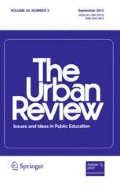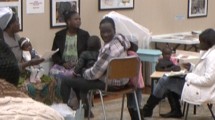Abstract
Disney videos are used across the US as important materials for teaching language arts and literacy in elementary schools. However, how pupils make meaning of the videos has not been sufficiently investigated in educational research. Twenty-five third-grade pupils were taught comprehension skills using Sleeping Beauty. The students created their understanding in visual images. Their drawings and explanations were analyzed using a social semiotic theory. The findings indicated that the students’ interpretations of Sleeping Beauty were not a decontextualized practice; rather, they used the specificity of their gender, social-cultural experiences and available multimodal resources at their disposal to construct interpretations of the video. The implications of the findings were discussed.







Similar content being viewed by others
References
Ajayi, L. (2008). Meaning-making, multimodal representation, and transformative pedagogy: An exploration of meaning construction instructional practices in an ESL high school classroom. Journal of Language, Identity, and Education, 7(3-4), 206–229.
Ajayi, L. (2009). ESL Adolescent Learners’ Exploration of Multimodal Texts in a Junior High School. Journal of Adolescent & Adult Literacy, 52(7), 585–595.
Buckingham, D., Banaji, S., Burn, A., Carr, D., Cranmer, S. & Willett, R. (2005). The media literacy of children and young people. Retrieved December 14, 2007, from http://www.ofcom.org.uk/advice/media_literacy/medlitpub/medlitpubrss/ml_children.pdf.
Buckingham, D., & Sefton-Green, J. (2004). Structure, agency, and pedagogy in children’s media culture. In J. Tobin (Ed.), Pikachu’s global adventure: The rise and fall of Pokémon (pp. 12–33). London: Duke University Press.
Cope, B., & Kalantzis, M. (2000). Design for social futures. In B. Cope & M. Kalantzis (Eds.), Multiliteracies: Literacy learning and the design of social features (pp. 203–234). London: Routledge.
Gee, J. P. (2001). Reading as situated language: A sociocognitive perspective. Journal of Adolescent & Adult Literacy, 44(8), 714–725.
Gee, J. P. (2003). What video games have to teach us about learning and literacy. New York: Palgrave Macmillan.
Gee, J. P. (2004). Situated language and learning: A critique of traditional schooling. New York: Routledge.
Gee, J. P. (2007). Pleasure, learning, video games, and life: The projective stance. In M. Knobel & C. Lankshear (Eds.), A new literacies sampler (pp. 95–113). New York: Peter Lang.
Giroux, H. (1993). Literacy and the politics of difference. In C. Lankshear & P. McLaren (Eds.), Critical literacy: Politics, praxis, and the postmodern (pp. 367–377). Albany, NY: State University of New York Press.
Giroux, H. (1996). Animating youth: The Disneyfication of children culture. In Fugitive cultures: Race, violence, and youth (pp. 89–113). New York: Routledge.
Giroux, H. (1999). The mouse that roared: Disney and the end of innocence. Lanham, MD: Rowman and Littlefield.
New London Group. (2000). A pedagogy of multiliteracies designing social futures. In B. Cope & M. Kalantzis (Eds.), Multiliteracies: Literacy learning and the design of social futures (pp. 9–74). London: Routledge.
Kress, G., & Street, B. (2006). Forward. In K. Pahl & J. Rowsell (Eds.), Travel notes from the new literacy studies: Instances of practice (pp. vii–x). Clevedon, England: Multilingual Matters.
Kress, G., & van Leeuwen, T. (1996). Reading images: The grammar of visual design. London: Routledge.
Kress, G., & van Leeuwen, T. (2001). Multimodal discourse: The modes and media of contemporary communication. New York: Oxford University Press.
Lee, S., Ajayi, L., & Richards, R. (2007). Teachers’ perceptions of the efficacy of the open court program for English proficient and English language learners. Teacher Education Quarterly, 34(3), 19–33.
Luke, A. (2003). Literacy and the other: A sociological approach to literacy research and policy in multilingual societies. Reading Research Quarterly, 38(1), 132–141.
Luke, C. (2003). Pedagogy, connectivity, multimodality, and interdisciplinary. Reading Research Quarterly, 38(3), 397–403.
Nixon, H. (2003). New research literacies for contemporary research into literacy and new media? Reading Research Quarterly, 38(3), 407–413.
Sefton-Green, J. (2006). Youth, technology, and media cultures. Review of Research in Education, 30(1), 279–306.
Swanson, C. (2008). Cities in crisis: A special report on high school graduation. Retrieved March 17, 2008, from www.americaspromise.org/uploadedFiles/Drop/out_Crisis/SwansonCities040108.pdf.
Swenson, J., Young, C., McGrail, E., Rozema, R., & Whitin, P. (2006). Extending the conversation: New technologies, new literacies, and English education. English Education, 38(4), 351–369.
U.S. Census. (2000). Languages spoken in the U.S. www.nvtc.gov/lotw/months/november/USlanguages.html.
Weedon, C. (2000). Feminism, theory and the politics of difference. London: Blackwell.
Zhao, W. (1996). Cinderella in eighties’ Hollywood. Retrieved from www.cmn.hs.h.
Author information
Authors and Affiliations
Corresponding author
Rights and permissions
About this article
Cite this article
Ajayi, L. A Multiliteracies Pedagogy: Exploring Semiotic Possibilities of a Disney Video in a Third Grade Diverse Classroom. Urban Rev 43, 396–413 (2011). https://doi.org/10.1007/s11256-010-0151-0
Published:
Issue Date:
DOI: https://doi.org/10.1007/s11256-010-0151-0




